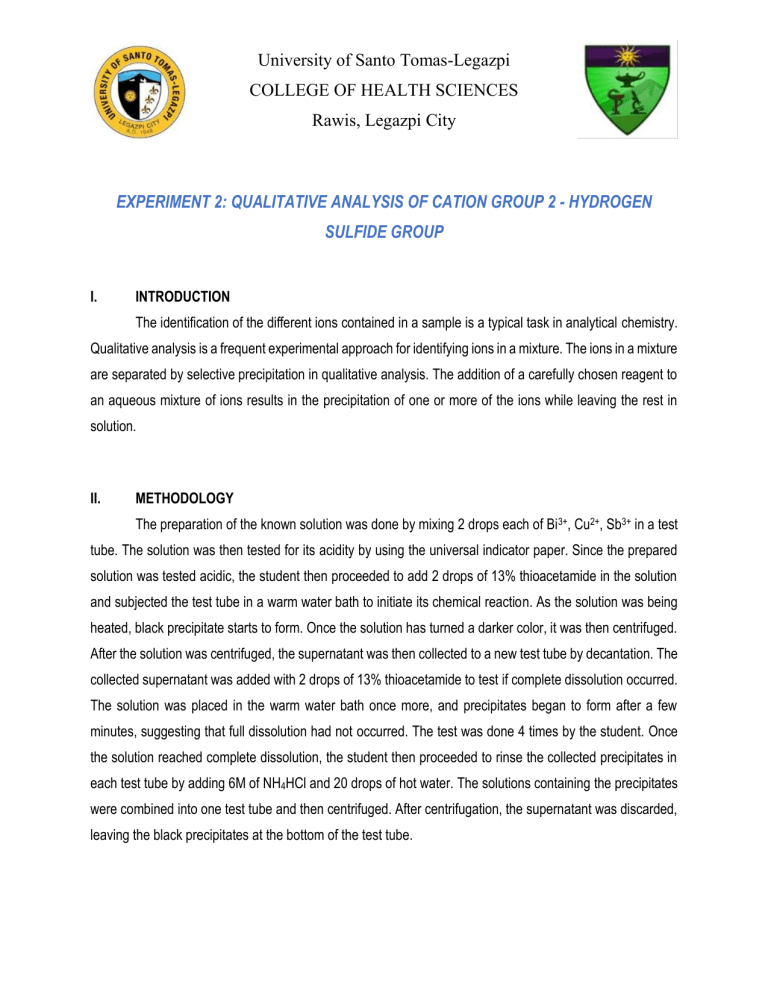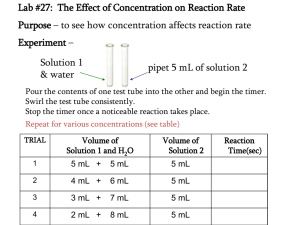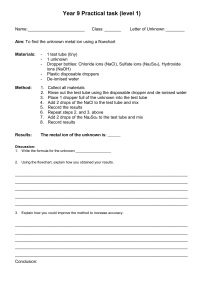
University of Santo Tomas-Legazpi COLLEGE OF HEALTH SCIENCES Rawis, Legazpi City EXPERIMENT 2: QUALITATIVE ANALYSIS OF CATION GROUP 2 - HYDROGEN SULFIDE GROUP I. INTRODUCTION The identification of the different ions contained in a sample is a typical task in analytical chemistry. Qualitative analysis is a frequent experimental approach for identifying ions in a mixture. The ions in a mixture are separated by selective precipitation in qualitative analysis. The addition of a carefully chosen reagent to an aqueous mixture of ions results in the precipitation of one or more of the ions while leaving the rest in solution. II. METHODOLOGY The preparation of the known solution was done by mixing 2 drops each of Bi 3+, Cu2+, Sb3+ in a test tube. The solution was then tested for its acidity by using the universal indicator paper. Since the prepared solution was tested acidic, the student then proceeded to add 2 drops of 13% thioacetamide in the solution and subjected the test tube in a warm water bath to initiate its chemical reaction. As the solution was being heated, black precipitate starts to form. Once the solution has turned a darker color, it was then centrifuged. After the solution was centrifuged, the supernatant was then collected to a new test tube by decantation. The collected supernatant was added with 2 drops of 13% thioacetamide to test if complete dissolution occurred. The solution was placed in the warm water bath once more, and precipitates began to form after a few minutes, suggesting that full dissolution had not occurred. The test was done 4 times by the student. Once the solution reached complete dissolution, the student then proceeded to rinse the collected precipitates in each test tube by adding 6M of NH4HCl and 20 drops of hot water. The solutions containing the precipitates were combined into one test tube and then centrifuged. After centrifugation, the supernatant was discarded, leaving the black precipitates at the bottom of the test tube. University of Santo Tomas-Legazpi COLLEGE OF HEALTH SCIENCES Rawis, Legazpi City The collected precipitate was then added with 10 drops of 0.5M KOH and was heated in a warm water bath. After being subjected to a warm water bath, it was centrifuged. The supernatant was then collected to a new test tube. III. RESULTS AND DISCUSSION In the experiment, Group II ions are separated by precipitating their insoluble sulfides. The sulfide ion is produced by the weak electrolyte gaseous hydrogen sulfide, which is only very slightly soluble in water. Hydrogen sulfide is created when thioacetamide undergoes hydrolysis. This reaction is catalyzed by the acidity of the solution and heat when subjected to the warm water bath. This ideal way of producing hydrogen sulfide is used to reduce the escape of the very dangerous and foul smelling gas into the environment, as well as to encourage the creation of purer, coarser, and more conveniently handled sulfide precipitates. Due to time restrictions, the test for the Group II cations was shortened during the experiment. It ended with the addition of KOH in the precipitate. University of Santo Tomas-Legazpi COLLEGE OF HEALTH SCIENCES Rawis, Legazpi City EXPERIMENT 2: QUALITATIVE ANALYSIS OF CATION GROUP 2 - HYDROGEN SULFIDE GROUP (LABORATORY REPORT) JOSE CARLOS BINOS 1BSMT1





